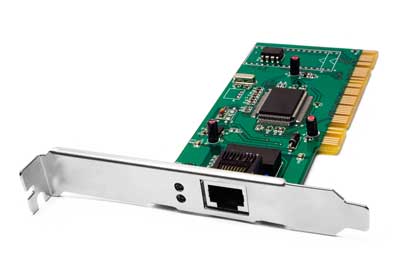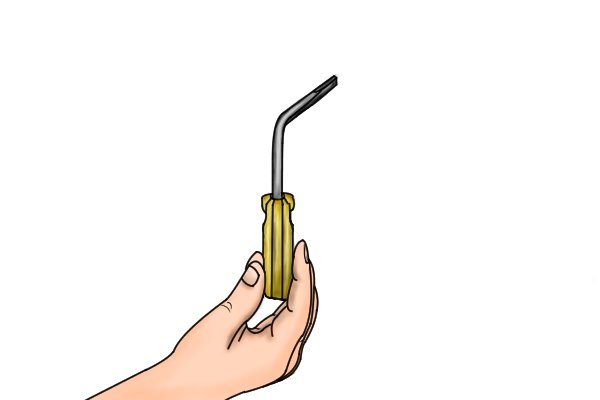COMPUTER PARTS AND FUNCTIONS
The central processing unit (CPU), also called a processor, is located inside the computer case on the motherboard. It is sometimes called the brain of the computer, and its job is to carry out commands. Whenever you press a key, click the mouse, or start an application, you're sending instructions to the CPU.The CPU is usually a two-inch ceramic square with a silicon chip located inside. The chip is usually about the size of a thumbnail. The CPU fits into the motherboard's CPU socket, which is covered by the heat sink, an object that absorbs heat from the CPU.A processor's speed is measured in megahertz (MHz), or millions of instructions per second; and gigahertz (GHz), or billions of instructions per second. A faster processor can execute instructions more quickly. However, the actual speed of the computer depends on the speed of many different components—not just the processor.
The Computer Case
The computer case is the metal and plastic box that contains the most
important components of the computer: the motherboard, the processor, random
access memory modules, the hard drive etc. It may not be possible to exchange
the components in a laptop computer, but in a desktop computer you have much
more influence on the parts inside the case.

The Motherboard
The motherboard is the part of the computer where such
things as the processor, memory modules, expansion cards and external devices
are attached. This means that the motherboard controls the functions of
different components. The number of connection slots for peripheral devices and
the number and type of memory slots are important properties of the
motherboard.
In addition to the various connections, the motherboard also has
a small battery ensuring that settings made on the board are retained even when
the computer is switched off.
The Processor
The processor can be considered to be the ‘engine’ of the
computer because it executes the lion’s share of the information processing;
the processor fetches commands and necessary information from the RAM, carries
out the tasks specified by the commands, and returns the processed information
to the RAM.
The speed of a computer depends largely on the speed of the
processor. The processor’s speed, in turn, is affected by various factors, such
as the so-called clock frequency (usually expressed as gigahertz, GHz), the
amount of cores and of the so-called cache memory inside the processor.
Random Access Memory
When the computer is started, the operating system is loaded
into the RAM (an operating system is a program that controls the devices and
programs in a computer – please see operating systems for more information). The computer also loads the files being
processed – music, assignments, videos etc – to the RAM.
If there is enough RAM, the computer executes requested tasks
quickly. This is why it is a good idea to add to the memory by buying more
memory modules as the need arises.
Hard drive
The hard drive is the permanent memory of the computer where
saved files remain even when the computer is turned off. This is why the hard
drive is used for saving files.
The capacity of hard drives varies; currently the typical
capacity is 500-1000 GB, but hard drives of over 1500 GB, i.e. 1,5 terabit, are
also available. However, the capacity of the internal hard drives in laptop
computers is often less than that.You can add to the capacity of your computer
by attaching an additional hard drive, either internally or externally. More
information about storage sizes can be found here.
The hard disk is used for the storage of the computer’s
operating system and all important files. It is therefore packed in a fixed
protective housing. The disks may become damaged in spite of this protection,
so you should absolutely make backup copies of files on the hard drive from
time to time
DVD and Blu-ray drives with writing capabilities
Most computers these days come with a Blu-ray drive
or a DVD (Digital Versatile Disk) drive
with writing capabilities, with which you can burn such things as backup copies
of important files to DVDs. CD drives are older and have mostly been
replaced with DVD drives. CD drives can only burn data on CDs, which have a
substantially smaller storage capacity, while DVD drives can burn data to both
CDs and DVDs with more capacity.
Read- Only Memory
 ROM, or read-only memory, is located here as well. This is a permanent, or non-volatile, memory. As soon as you turn on your computer, the start-up instructions that are stored in ROM begin to execute. Even when you turn it off, the instructions stored in ROM remain. So if you have a machine that runs Windows, as soon as you hit the power-up button, you'll get a short screen that might give you a message from the manufacturer. Then in the background you'll just see black and the Windows logo come through, and it will say 'Starting Windows.' What's going on there is that as soon as you hit the power button, your ROM is kicking in and starting up all those instructions for systems checks.
ROM, or read-only memory, is located here as well. This is a permanent, or non-volatile, memory. As soon as you turn on your computer, the start-up instructions that are stored in ROM begin to execute. Even when you turn it off, the instructions stored in ROM remain. So if you have a machine that runs Windows, as soon as you hit the power-up button, you'll get a short screen that might give you a message from the manufacturer. Then in the background you'll just see black and the Windows logo come through, and it will say 'Starting Windows.' What's going on there is that as soon as you hit the power button, your ROM is kicking in and starting up all those instructions for systems checks.Sound Card
The sound card, also called an audio card, is responsible for what you hear in the speakers or headphones. Most motherboards have integrated sound, but you can upgrade to a dedicated sound card for higher-quality sound.
Video Card
Network Connections
A part of the system unit most of us take for granted these days is the wireless local area network card, or the WLAN card. This is the card you actually don't see signs of from the outside of your unit, but it is what lets us connect to our wireless internet.
Another way to connect to a network is by hardwire, or plugging a jack into the network interface card (NIC). This looks like a telephone receptacle, but is slightly larger.
Expansion card
Bluetooth card (or adapter)
The power supply unit in a computer converts the power from the wall outlet to the type of power needed by the computer. It sends power through cables to the motherboard and other components.
If you decide to open the computer case and take a look, make sure to unplug the computer first. Before touching the inside of the computer, you should touch a grounded metal object—or a metal part of the computer casing—to discharge any static buildup. Static electricity can be transmitted through the computer circuits, which can seriously damage your machine.The Display and Display Adapter
Most computer displays are so-called LCD displays (Liquid
Crystal Display), where the image display is produced by liquid crystals
between two transparent sheets. Display sizes range between only a few inches
in handheld apparatuses to large 24 inch desktop displays.
One of the most important features of the display is its resolution, i.e. how
many pixels (picture elements) the image consists of. A normal 22 to
24-inch widescreen display usually has 1920 pixels horizontally and 1200 pixels
vertically (1920×1200). These displays can reproduce FullHD (full high definition) image.
No matter what the type of display is, the computer must
contain a so-called display adapter that allows you to attach the display
to the computer and controls the display image. Practically all motherboards
come equipped with a display adapter, so you do not need to buy one separately,
unless you want to enhance the capabilities of your desktop computer e.g. for
gaming, video editing, or 3D imaging purporses.
Keyboard
An assemblage of systematically arranged keys by which a machine or device is operated. A standard keyboard has 102 keys. The keys are divided into
alphabetical (a-z), numerical (1-0) and special (Function, Ctrl, Alt etc keys).
In addition to the usual alphabetical and numerical keys, you
should know at least the following special keys that are located among the
alphabetical ones.
Pointing Devices
Traditionally, most programs have been designed to be used with
a mouse. The mouse cursor seen on the screen of the computer moves along with
the mouse. The cursor can be used to select menu commands and areas, as
well as activating different objects by clicking the mouse keys.

Mouse
You can attach a traditional mouse with or without a cord to any
computer. Cordless mice use radio waves to relay movement from the mouse to the
computer (for this mouse, a small radio receiver is attached to the computer).

Touchpad
Touchpad
Almost all laptop computers have a touchpad which
is used to move the cursor. Some models also have a so-called pointing stick. In addition, portable computers
have keys with the clicking function of mouses. The touchpad is
a pad where you can control the cursor by moving your finger along the pad.
Tapping the pad serves the same function as clicking a mouse.

Pointing stick
Pointing stick
The pointing stick is
a ‘nub’ located in the middle of the keyboard, and controls the cursor. The
pointing stick can be ‘clicked’ by tapping the stick or using the separate
buttons in the keyboard. In the right-hand image above, you can see a portable
computer with both a pointing stick (blue) and a touchpad (the large, dark grey
area in front of the keyboard).
Touchscreen
Devices that are smaller than a laptop, such as phones and
tablets, usually do not have a separate keyboard or pointer device. In these
devices, the entire screen of the device works as an input device. A touchscreen is
used like the track pad on a laptop, and when typing is required, a keyboard
appears on the screen.
Credits and Courtesy:
For the Images:
- http://blogs.helsinki.fi/ict-driving-licence/files/2004/11/emoiso.jpg
- http://blogs.helsinki.fi/ict-driving-licence/files/2004/11/prossuiso.jpg
- http://blogs.helsinki.fi/ict-driving-licence/files/2004/11/Open_hard-drive_wikimedia_publicdomain.jpg
- http://blogs.helsinki.fi/ict-driving-licence/files/2004/11/muistiiso.jpg
- http://blogs.helsinki.fi/ict-driving-licence/files/2004/11/dvdasema_isompi.jpg
- http://blogs.helsinki.fi/ict-driving-licence/files/2004/11/lcdiso.jpg
- http://blogs.helsinki.fi/ict-driving-licence/files/2004/11/nappis_isompi.jpg
- http://blogs.helsinki.fi/ict-driving-licence/files/2004/11/optohiiriiso.jpg
- http://blogs.helsinki.fi/ict-driving-licence/files/2004/11/ohjaustappijataso_isompi.jpg
- http://blogs.helsinki.fi/ict-driving-licence/files/2004/11/tvtpad800x1000.jpg
- https://infinitelovefortecnology.files.wordpress.com/2015/02/oie-zi.png
- http://s192804805.onlinehome.us/images/1/6300/CT4810-2.jpg
- http://www.geekhowtos.com/wp-content/uploads/2011/08/graphic-card-1.jpg
- http://image.dhgate.com/albu_849810215_00/temp2.0x0.jpg
- http://totalsystemcare-s3.s3.amazonaws.com/safebytes.com/wp-content/uploads/2016/03/10212145/computer-expansion-image.jpg


